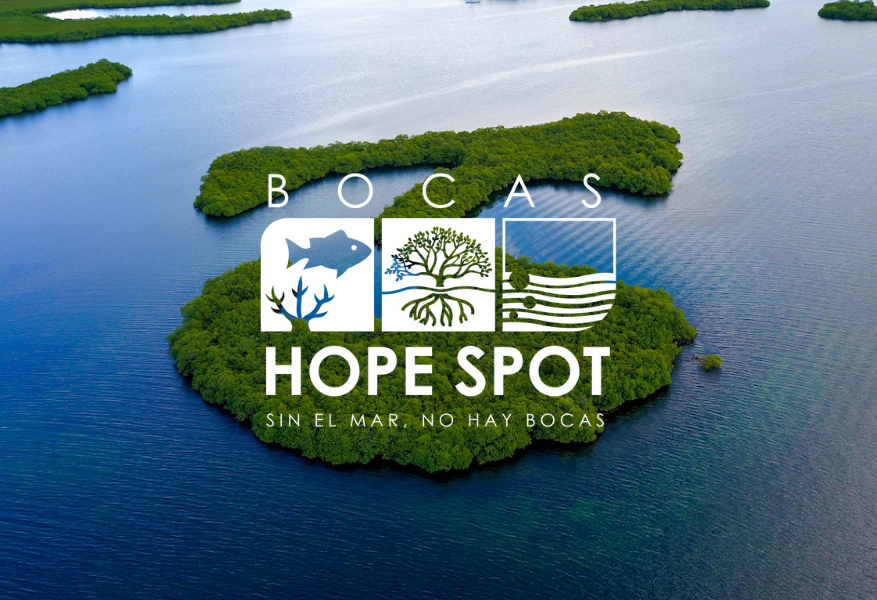Hope Spot - So What?
The Bocas del Toro Archipelago was declared a Hope Spot in 2019 by Mission Blue, a community focused call to action for championing Marine Protected Areas (MPAs) globally, spearheaded by the legendary oceanographer and ocean activist Sylvia Earle. Sounds pretty cool, right? But how does this impact you?

We need to consider that 70% of planet Earth is ocean. One great big ocean. We occupy less than 30% of this world, appearing only as temporary visitors to the remainder. The ocean currently absorbs around 25% of CO2 emissions every year (1). This ability of the ocean to capture and store carbon, has helped to slow the accumulation of atmospheric carbon greatly benefiting both us and the natural world. Additionally, scientists estimate that roughly half of the planet’s oxygen comes from our ocean. So our ocean is vital for sustaining life, including our own, on this planet.
We know we are reaching a crucial point in humanity’s relationship with the natural world. There is work being done globally to try to shift the course of our future on this planet from phasing out fossil fuels, rewilding land and protecting species extinction. Often we forget about protecting our ocean (out of sight, out of mind), seeing it as a never ceasing supply of food, entertainment and beauty. An estimated 3 billion people worldwide rely on the sea for food security and 10 to 12 percent of the world’s population rely on it for income (2). Yet due to poor fishery management, ocean acidification, rising sea temperatures and coastal development, to name just a few, our oceans are dying. They desperately need our help.
In January 2021 more than 50 nations agreed to the ‘30×30’ initiative to designate 30% of Earth’s land and oceans as protected areas by 2030. In October 2022, this had increased to 100 countries. Today an estimated 7.65% of the ocean is covered by Marine Protected Areas (MPAs). That same year, Panama became one of the first countries in the world to protect 30 percent of its territorial waters (3). The Panamanian government set a fantastic example for the rest of the world, committing the country to conservation and wildlife protection. The vast majority of this protected zone lies in Cordillera de Coiba Marine Protected Area which sits within the Eastern Tropical Pacific Marine Corridor. This marine reserve connects with others in Costa Rica, the Galapagos and even stretching up to California, creating an important migratory route for whales, dolphins, sharks, sea turtles and manta rays.
The Archipelago of Bocas del Toro has one marine protected area, Bastimentos Marine Park, located outside the main bay. The first marine park to be established in Panama, in 1988, it has successfully helped to keep the islands of Cayo Zapatillas. However, inside the bay the marine environment is feeling the pressure from increased visitors to the area. Bocas has seen a rapid increase in tourists, flooding to this relatively undiscovered Caribbean paradise for pristine beaches, world-class surfing, vibrant nightlife and beautiful coral reefs. 95% of the local economy is now tourism based, meaning that almost every individual living in the archipelago now relies on an inflow of visitors. Unfortunately with this increase in visitors, water conditions have seriously deteriorated in recent years. Eutrophication (meaning excessive nutrients), sedimentation and turbidity (water clarity) have put a strain on the corals, and local groups are seeing a massive reduction in the abundance of coral species. Corals are just one part of declining biodiversity loss. All important mangroves are also being eroded by coastal development, many fish species are in decline and impact damage to the substrate are also contributing to declining biodiversity. Visitors are, for the most part, unknowingly contributing to the destruction of the very thing they are coming to experience. In the words of Sylvia Earle, “Bocas del Toro is a stunning pocket of biodiversity…once human activities destroy the natural ecosystem here, we might not get it back.” (4).
It is, however, not too late to save this special place. This is why Bocas del Toro was selected as a ‘Hope Spot’, in an effort to shine a light on this unique coastal region and the challenges it faces. Hope Spots aim to select areas that need to be targeted for MPAs which is the outcome that all involved are aspiring towards. A complete management system for the entire marine area needs to be implemented to ensure that the local Bocatoranians can continue to thrive from ecotourism and localised, scientifically managed fishing. It is a microcosm of what we need worldwide and a perfect example of the issues we are facing across the globe.
Many fantastic organisations including Mother of Coral and The School for Field Studies are coming together to do what needs to be done. Ankay Conservation is a member of the Hope Spot alliance and works together with other parties to educate, monitor and inform the local and tourist communities. With your help, we can all work towards preserving this beautiful place for generations to come.
References
(1) United Nations, United Nations website, Accessed 16 May 2023, https://www.un.org/en/climatechange/science/climate-issues/ocean#:~:text=The%20ocean%20generates%2050%20percent,the%20impacts%20of%20climate%20change
(2) The Nature Conservancy 2021, The Nature Conservency website, Accessed 16 May 2023, https://www.nature.org/en-us/what-we-do/our-priorities/provide-food-and-water-sustainably/food-and-water-stories/global-fisheries/#:~:text=Fish%20and%20other%20seafood%20products,percent%20of%20the%20world’s%20population
(3) Mission Blue 2021, Mission Blue website, Accessed 16 May 2023, https://missionblue.org/2021/06/panama-achieves-30×30-ocean-protection-goals-in-newly-expanded-cordillera-de-coiba-marine-protected-area/
(4) Mission Blue 2020, Mission Blue website, Accessed 16 May 2023, https://missionblue.org/2020/02/new-hope-spot-in-panama-champions-a-push-for-a-healthier-environment/#:~:text=Mission%20Blue%20has%20declared%20the,an%20expanded%20and%20enforced%20marine
